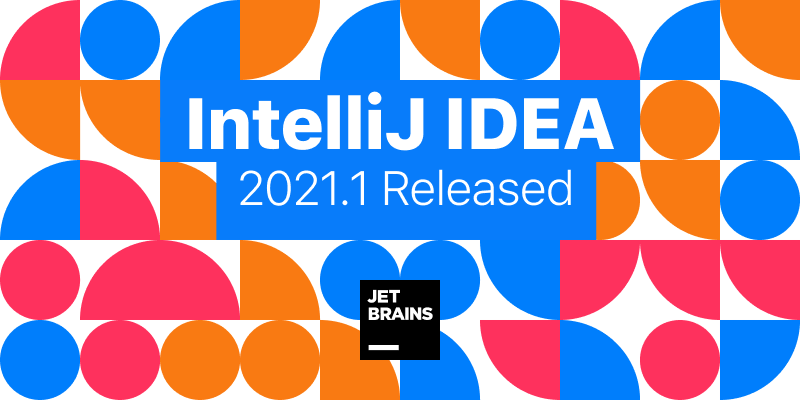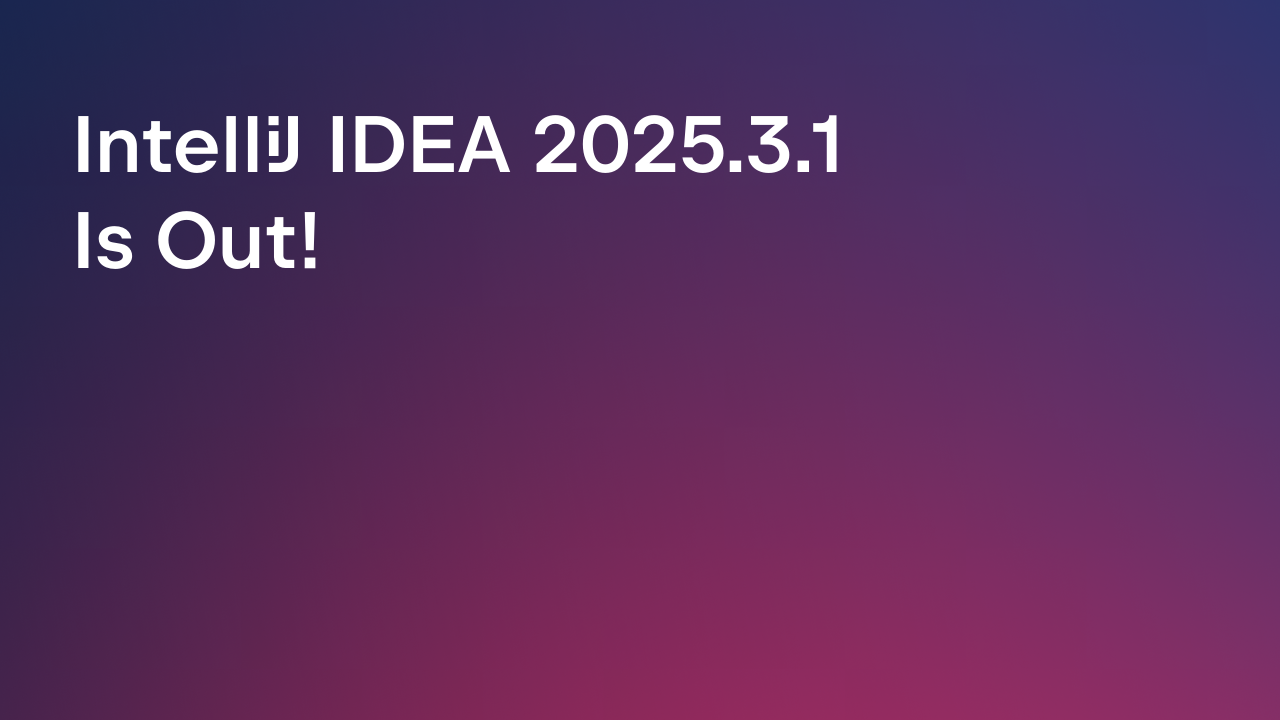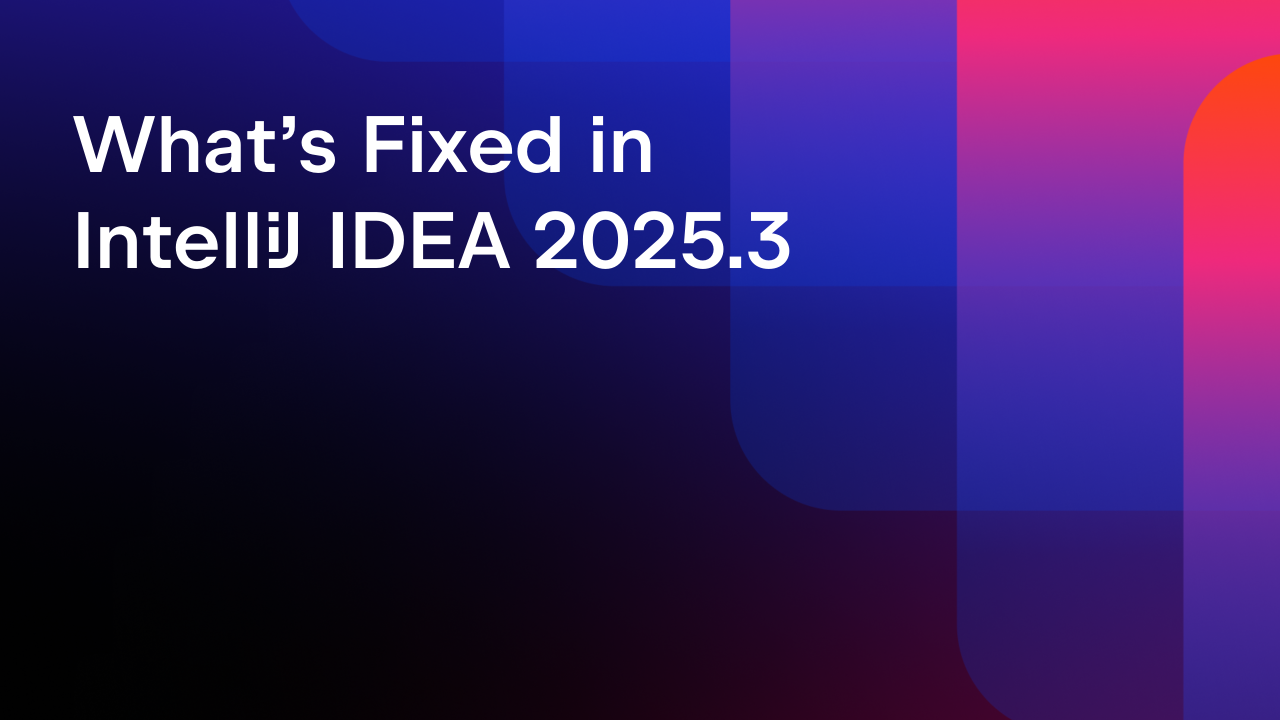IntelliJ IDEA
IntelliJ IDEA – the Leading IDE for Professional Development in Java and Kotlin
IntelliJ IDEA 2021.1 is Out!
Today is a big day for us – IntelliJ IDEA 2021.1, our first release of the year, is available! Download it from our website or using the Toolbox App. You can also upgrade from inside the IDE or use snaps if you are an Ubuntu user.

This version has solved some troubling issues and introduced many new features. You can now work with your Java projects in WSL 2, use integrated Space, arrange video calls for collaborative development with Code With Me right from the IDE, and run code on SSH hosts and in Docker containers. We’ve also added basic support for Java 16, some useful new inspections, and an HTML preview window inside the IDE. There are many more updates to almost every part of your IDE.
Without further ado, let’s have a look at the most significant updates in the video overview.
The detailed descriptions of all the changes are in our EAP blogs and on the What’s New page. Check them out!
In this post, you can quickly browse through all the significant features in v2021.1:
Key updates
- Integration with Space, our new platform for software development and team collaboration, is now available out of the box.Once you log in to your organization in JetBrains Space, you can view and clone project repositories, review your teammates’ code, and write Space automation scripts. Learn more.
- We now support WSL 2 for Java projects.
- Code With Me, a service for collaborative development and pair programming, now comes out of the box featuring video and audio calls.
- The new Run Targets feature allows you to run, test, profile, and debug your application in Docker containers or on remote machines.
User experience
- Your IDE features a built-in browser preview for HTML files. The preview updates on the fly when you change your HTML or the linked CSS and JavaScript files.
- It is possible to include or exclude External Dependencies in the search scope.
- We’ve labeled several UI and gutter elements to be read out correctly with the enabled screen reader.
- If you use the high-contrast mode on Windows, your IDE will automatically apply the high-contrast theme upon its first launch.
- If you are a Windows user, you can open your recent projects by right-clicking on the IntelliJ IDEA icon on the taskbar or the Start menu.
Version Control
- This release introduces several updates for Pull Requests, including faster creation, the ability to open the in-editor diff quickly, and support for pull request templates.
- We’ve added support for Git commit templates in which you can outline the custom information you need in the commit message.
- You can now easily choose a code inspection profile before committing changes to VCS – just click the gear icon to show commit options, tick the Analyze code checkbox, click Choose profile, and select the desired profile.
- The new down-arrow icon next to Show diff in the Compare with branch dialog allows you to get a file from another branch.
- It is possible to copy your changes to the Shelf while keeping them in the local changes with our new Save to Shelf action.
- The Perforce plugin is now fully compatible with IntelliJ IDEA Community Edition and comes bundled with your IDE.
Editor
- New typography settings in Preferences / Settings | Editor | Fonts let you fine-tune the weight of your main and bold font styles.
- Whenever several tabs that split the editor vertically are open, you can double-click either of them to maximize the editor window for that specific tab.
- Your IDE supports JSONPath expressions with the Goessner or Jayway syntaxes. The new Evaluate JSONPath Expression action for writing queries in JSONPath and testing them is available via Edit | Find.
- IntelliJ IDEA has support for the JSON Lines format, recognizing .jsonl, .jslines, .ldjson, and .ndjson file types.
Profiler
- We reworked the Profiler UI and added two new actions that you can access with a right-click on a running application. Capture Memory Snapshot action allows you to take *.hprof snapshots of your applications, and CPU and Memory Live Charts opens a tab with tools for tracking and visualizing resource consumption.
Java
- IntelliJ IDEA has basic support for Java 16, which was released in March 2021.
- We’ve added several new inspections, including ones for data flow analysis.
- We’ve introduced new formatting options for chained builder methods to help improve their readability.
Kotlin
- We’ve increased the code analysis speed making it possible to detect errors and warnings much faster.
- If you use functions that require type parameters, the IDE adds the correct type parameter to the preceding code.
- UML class diagrams now work for Kotlin compiled to JVM.
- IntelliJ IDEA’s own code coverage runner now fully supports Kotlin in inline functions and coroutines.
- The IntelliJ IDEA debugger can evaluate get expressions in Kotlin and display them in the Variables view.
- We’ve reworked the UI for the Change Signature refactoring and added a new checkbox that lets you set the added parameter as the default one.
JavaScript
- Fixing code problems with Stylelint is now easier – just hover over a problem or place a caret on it, press Alt+Enter, and select Stylelint: Fix current file.
- Quick MDN documentation for JavaScript APIs, HTML, and CSS is now embedded in your IDE.
- You can now check the specificity of your selectors when working with style sheets.
Scala
- The Type Diff tooltip now supports kinds.
- This release introduces Scala code completion based on machine learning.
- In addition to modules, compilation charts can now show compiler phases and units, so you can gain even deeper insight into your compilation.
- The sbt-idea plugin makes it possible to develop IntelliJ Platform plugins using Scala and sbt. There’s now a built-in Project Wizard template to make the process even easier (this feature depends on the Plugin DevKit).
Database tools
- We’ve added a UI for editing grants when modifying objects. This update is available for PostgreSQL, Redshift, Greenplum, MySQL, MariaDB, DB2, SQL Server, and Sybase.
- We’ve added live templates that allow generating simple statements straight from the database explorer.
- We’ve simplified the navigation – Go to declaration (Ctrl/Cmd+B) invoked on an object in SQL now takes you to the DDL, not to the database tree.
- We’ve improved the sorting of data.
- The most famous shortcuts in the world Ctrl/Cmd+C/V/X now work for copying, cutting, and pasting data sources.
- You can now edit data in MongoDB collections. A statement preview is also available.
Build tools
- We’ve brought back the ability to customize settings when importing Maven projects.
Frameworks & Technologies
- The new inspection highlights http:// protocol usages and offers to change them to https://.
- The HTTP client comes with several updates. You can collapse the returned HTML, JSON, or XML, as well as copy its body, hide line numbers, choose the display format, and quickly scroll to the top and the bottom of the response.
- If you use SSL client authentication for https:// protocols, you can configure SSL settings in the HTTP client.
- When you create Spring, Micronaut, Quarkus, and MicroProfile projects, it only takes two steps to start working with them. You can enter all the key information on the first screen of the updated wizard and configure framework-specific settings on the second one.
- We’ve added redesigned and clickable icons to the gutter for projects that include JPA entities. We’ve also improved JPA support for Kotlin and multi-module projects.
- You can use the JPA console for writing and running JPQL queries in Jakarta EE 9 projects.
- If you use our light theme, the UML Diagrams will update with a new color scheme.
- Swagger supports specifications with external file references ($ref) and more nodes in the Structure view for specification files.
- We’ve added a new experimental tool for detecting DOM elements of a web application. You can access it via Tools | Generate Selenium Page Object.
Other
- Support for publicly available shared indexes is embedded into IntelliJ IDEA Community Edition.
- IntelliJ IDEA now supports all Android Studio 4.1.1 updates.
- IntelliJ IDEA can now import OSGI facet settings from the bnd-maven-plugin.
Quite an impressive list, don’t you think? We hope you’ll enjoy all the new features and work bug-free with fixed functionalities.
As always, you can check out the release notes that contain both major and minor updates, share your feedback in the comments to this post, and report any bugs to our issue tracker.
Happy developing!
Subscribe to IntelliJ IDEA Blog updates








